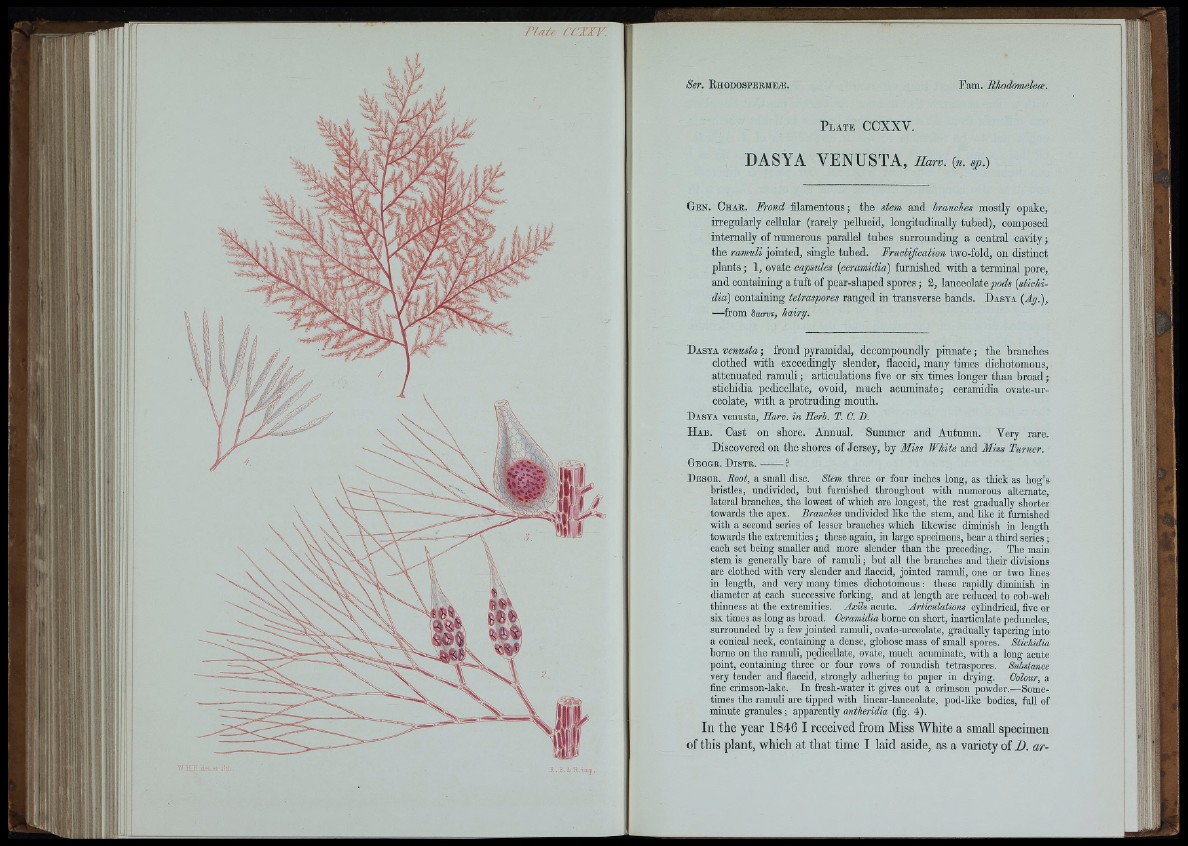
P la i e P P X IF :
P l a t e CCXXV.
DASYA VENUSTA, H a r v . {n. sp .)
Gen . C h a b . Frond filamentous; th e stem and hranches mostly opake,
irregularly cellular (rarely pellucid, longitudinally tubed), composed
internally of numerous parallel tubes surrounding a central c avity;
the ramuli jointed, single tubed. Fructifioation two-fold, on distinct
p la n ts ; 1, ovate capsules [ceramidia) furnished witb a terminal pore,
and containing a tu ft of pear-shaped spo re s; 2, la n o e o la te /o * {stichidia)
containing tetraspores ranged in transverse bands. D a s y a {Ag.),
— from SaoTis, -
D a s y a venusta ; frond pyramidal, decompoundly pinnate ; the branches
clothed with exceedingly slender, flaccid, many times dichotomous,
attenuated ramuli ; articulations five or six times longer than broad ;
stioliidia pedicellate, ovoid, much acuminate; ceramidia ovate-ur-
ceolate, with a protruding mouth.
D a s y a venusta, Harv. in Herh. T. 0. D.
H a b . Cast on shore. Annual. Summer and Autumn. Very rare.
Discovered on the shores of Jersey, by Miss White and Miss Turner.
G e o g b . D i s t b . ?
D e s o b . Boot, a small disc. Stem three or four inches long, as thick as hog’s
bristles, undivided, b u t furnished throughout with numerous alternate,
lateral hranches, th e lowest of which are longest, the re st gradually shorter
towards th e apex. Branches undivided like the stem, and like it furnished
with a second series of lesser hranches which likewise diminish in length
towards th e extremities; these again, in large specimens, bear a th ird series;
each set being smaller and more slender th a n the preceding. The main
stem is generally bare of ram u li; b u t all th e hranches and the ir divisions
are clothed with very slender and flaccid, jointed ramuli, one or two lines
in length, and very many times dichotomous: these rapidly diminish in
diameter a t each successive forking, and a t length are reduced to cob-web
thinness at the extremities. Axils acute. Articulations cylindrical, five or
six times as long as broad. Ceramidia borne on short, inarticulate peduncles,
surrounded by a few jointed ramuli, ovate-m-ceolate, gTadnally tapering into
a conical neck, containing a dense, globose mass of small spores. Stichidia
borne on the ramuli, pedicellate, ovate, much acuminate, with a long acute
point, containing three or four rows of roundish tetraspores. Substance
very tender and flaccid, strongly adhering to paper in drying. Colour, a
fine crimson-lake. In fresh-water it gives out a crimson powder.— Sometimes
the ramuli are tipped with linear-lanceolate, pod-like bodies, full of
minute g ran u le s ; apparently antheridia (fig. 4).
In the year 1846 I received from Miss White a small specimen
of this plant, which at that time I laid aside, as a variety of D. a r